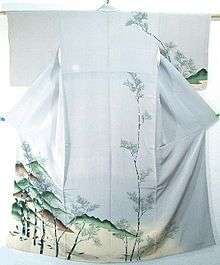Hōmongi

The Hōmongi (訪問着) kimono replaces the role of the furisode when a woman marries. It is given to the woman when she marries, to signify her womanhood has transcended into a married life. It is of a less colourful and attention-drawing than the kimono of unmarried women, but it can be worn by unmarried women too. Directly translated homongi means "visiting wear" and it was very popular among the upperclass women in the Meiji era to wear as a formal dress for going out. The homongi is the most ostentatious kimono for married women and the second most for unmarried women. Usually, the homongi kimono is worn to tea ceremonies and weddings.[1]
The homongi is characterized by flamboyant and colourful pattern running continuously over the seams. The sleeve length varies and unmarried women wear longer sleeves. It is mostly worn with a fukuro obi with a matching obiage and obijime. [2]